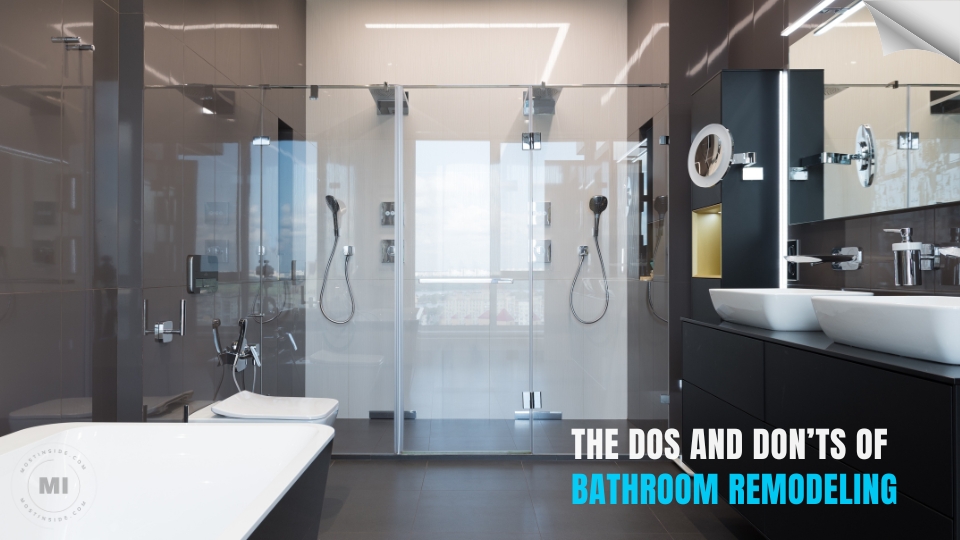The Dos and Don’ts of Bathroom Remodeling: A Brief Guide

Even bathrooms with the best designs can become antiquated or worn out over time. When that happens, bathroom remodeling offers a new beginning and the possibility to design a place that exactly reflects your preferences and demands.
Bathroom remodeling is crucial because it raises the value of your home while enhancing the look and functionality of your bathroom. A remodeled bathroom gives your property an advantage in a competitive housing market and increases its attractiveness to prospective buyers. A well-done bathroom redesign can help you sell your home fast and for a desired price in places like Traverse City, where the typical time to sell a property is 32 days.
In this article, we’ll look at the dos and don’ts of bathroom remodeling, giving you insightful advice on how to make your project a success.
1. Do Splurge On The Shower
The shower is often the centerpiece in a bathroom, so investing in a good-looking, high-quality shower can significantly improve your bathroom’s aesthetics and functionality. Look for showers that combine both design and functionality. Consider amenities like built-in seats, spray settings, and adjustable showerheads.
Finding a reliable shower replacement firm specializing in high-quality work is crucial if you’re considering replacing your shower. Make sure you choose a business with a history of producing top-notch results by doing homework and reading reviews.
It’s also a good idea to research local shower replacement prices on average. For instance, if you are in Traverse City, where the typical cost to repair a shower stall is $258.00, this knowledge can assist you in creating a reasonable budget and identifying the top Traverse City shower replacement companies that offer quality services at reasonable rates.
2. Do Find Design Inspiration
To find ideas that fit your unique style, look through various sources, including home renovation magazines, online resources, and showrooms. Look for bathroom designs that have components you like, like color schemes, furnishings, fixtures, and layouts. Whatever general aesthetic you wish to achieve—modern, traditional, rustic, or minimalist—keep it in mind. Defining your preferences and creating a plan for your remodeling project are aided by early design inspiration. It facilitates the process by enabling you to express your vision to specialists clearly and concisely.
3. Do Consider Your Budget
Establishing a reasonable budget and clearly understanding your financial constraints before beginning any restoration job is crucial. You may then prioritize your remodeling goals and make well-informed choices about how to allocate your resources. Evaluate your budget and decide how much you will set aside for the bathroom renovation. Consider every aspect of the project, including the materials, equipment, labor, and unforeseen costs. To determine what falls within your budget, compare the costs of various supplies and fixtures. Do not forget to include a contingency fund to cover any unanticipated events or changes during remodeling.
4. Do Choose Quality Materials
Choosing high-quality flooring, like ceramic tiles or vinyl, can help save wear and tear by withstanding moisture and frequent use in a bathroom. Similar to flooring, choosing worktops made of moisture-resistant materials like quartz or granite will not only have a classy appearance but also be resistant to stains and damage. Prioritize quality over money when purchasing faucets, showerheads, and toilets. Spending money on fixtures constructed of long-lasting materials like brass or stainless steel can prevent leaks, corrosion, and continual replacements. Additionally, better warranties are frequently offered with high-quality materials, providing long-term peace of mind.
5. Don’t Neglect Proper Ventilation
Without sufficient ventilation, mold, mildew, and foul odors can flourish in your bathroom. Accumulation of moisture can result in deterioration of structures and health risks. Consider placing or upgrading an exhaust fan that efficiently extracts moisture and steam from the bathroom to maintain optimum ventilation. Select a fan whose airflow capacity corresponds to the size of your bathroom. Ensure that the exhaust fan is vented outside of your house as well, not simply into the attic or ceiling area.
6. Don’t Overlook Plumbing Considerations
As it may require cutting into walls, redirecting pipes, or adjusting the primary plumbing system, moving plumbing fixtures, pipes, or drains can be expensive and laborious. You can cut costs and problems by doing as much of your plumbing work within the existing framework. However, if you need to make changes, you must speak with a qualified plumber who can offer expert advice and guarantee that the adjustments are made properly. Be mindful of plumbing installation-related building requirements and rules as well, as non-compliance can result in problems in the future.
7. Don’t Sacrifice Storage
While it may be tempting to concentrate only on aesthetics or maximize floor space, ignoring storage might result in an unusable and disorganized bathroom. Consider including built-in niches, cabinets, shelves, vanity units, and other storage options in your redesign. These components can assist in organizing bathroom staples like towels, toiletries, and cleaning products so that they are all conveniently close at hand. Based on your way of life and the number of people using the bathroom, evaluate the requirements for storage.
8. Don’t Ignore Lighting
For a bathroom setting that is balanced and aesthetically pleasing, a thoughtful lighting design is essential. Consider the following essentials:
- Adding windows or skylights may increase natural light while saving electricity.
- For grooming tasks, concentrate on task lighting with strategically placed wall sconces or vanity lights to reduce shadows.
- Use ambient lighting, such as pendant or recessed ceiling lights, to create a warm ambiance.
- To enhance depth and visual appeal, accent lighting can emphasize architectural details, works of art, or ornamental components.
- Install dimmers so you may adjust the lighting intensity to suit your needs and moods.
Conclusion
Careful preparation and adherence to the dos and don’ts listed in this quick guide are necessary for a bathroom remodeling project to be successful. Homeowners may guarantee a seamless and happy renovation experience by considering elements like budgeting, aesthetics, practicality, and professional guidance. Remember to emphasize high-quality materials, effective space utilization, and enough ventilation while avoiding typical mistakes like ignoring the requirement for plumbing and overcomplicating the design. Making your bathroom attractive and useful is well within your grasp with the appropriate strategy and attention to detail.
You may like this
Recommended For You
How To Keep Your Room Well Organized?
Most Inside
Most Inside offers high-quality recommendations and valuable updates to enhance all aspects of your life, providing premium guidance and enriching experiences.




